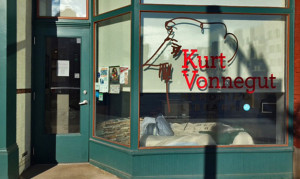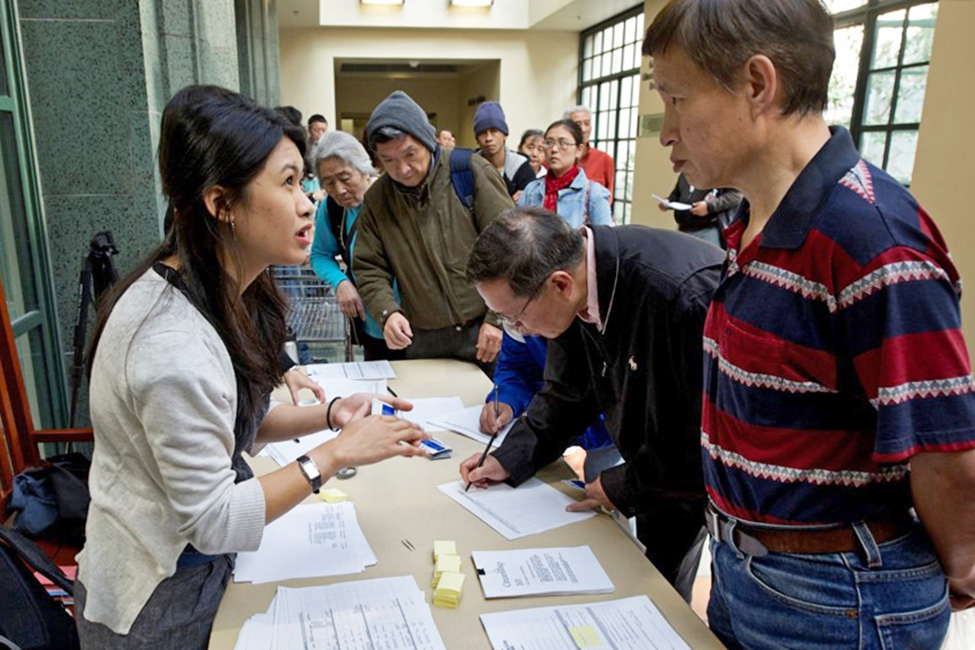
As many Americans reflect on the rights and responsibilities of citizenship on this Citizenship Day and Constitution Day, September 17, American Libraries takes a look at the role public libraries have had in the lives of immigrants seeking information, referrals, or a pathway to citizenship.
Libraries across the country have long provided programming and resources to immigrants, including citizenship workshops, English-language classes, interview simulation, and government-issued educational materials to help them prepare for naturalization. But today, a few libraries are going beyond the scope of traditional services, taking advantage of a unique provision under federal law that allows people who aren’t attorneys to administer legal services to immigrants.
“We realized we had to go for accreditation because there’s a fine line between legal advice and helping someone on the computer,” says Homa Naficy, chief adult learning officer for Hartford (Conn.) Public Library (HPL).
Naficy is referring to Board of Immigration Appeals Recognition and Accreditation (BIA R&A), granted by the Department of Justice (DOJ), which allows nonlawyers with approved training and the backing of a recognized nonprofit organization to legally represent immigrants. In 2013, HPL was the first public library to become a recognized site. It was a way for the library to improve its citizenship program, The American Place, and meet demand from local immigrant and refugee populations, which includes individuals from Columbia, Peru, and the West Indies. Before HPL had authorization to provide legal advice and services to immigrants, Naficy notes, “We were at a standstill. We would have to refer [people outside the library], and we’d lose customers.”
BIA R&A may be a direction for more libraries to explore as increasing numbers of the estimated 11 million undocumented immigrants in the US turn to libraries to determine their status and eligibility for citizenship, permanent residency (green card), or, pending a federal court decision expected next year, Deferred Action for Childhood Arrivals (DACA) or Deferred Action for Parental Accountability (DAPA). Right now, DOJ lists three libraries on its recognized organizations roster—HPL, Queens Borough (N.Y.) Public Library, and Littleton (Colo.) Immigration Resources Center (LIRC), which operates out of the Bemis Library—and more libraries seem interested in joining the list.
“There is plenty of opportunity to be done just screening undocumented people,” says Jack Holmgren, California legalization director for Catholic Legal Immigration Network, Inc. (CLINIC), an organization that works with both Catholic and non-Catholic community legal immigration programs—including HPL and Bemis Library. “There are a lot of undocumented people who don’t know what their rights are.”
“Most of us just associate lawyers with the practice of law,” Holmgren adds. “Most people are surprised to learn that nonattorneys can practice immigration law if they have sufficient training.”
How the recognition and accreditation program works
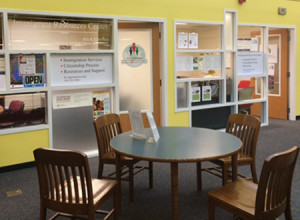
BIA R&A has many intended functions, including providing a way for immigrants to get lower-cost legal services, increasing service capacity in geographic areas where there may be few immigration attorneys, and curtailing fraud by providing a federally vetted and approved alternative in communities where scammers may represent themselves as immigration experts or notarios publicos (the connotation of the “notary public” can mean something entirely different in Spanish-language countries, often implying the person is “legally connected” or can represent someone before the government).
BIA provides two types of accreditation with different privileges: partial and full. A partially accredited representative can represent immigrants before the Department of Homeland Security and help a client fill out US Citizenship and Immigration Services (USCIS) forms, while a fully accredited representative can do those things but also represent individuals before the Executive Office for Review, Immigration Courts, and BIA.
HPL and Bemis Library picked partial accreditation for their staffers because it best fits the scope of services they choose to offer. “Partially accredited representatives can do screenings, help people with DACA applications or N-400 forms—anything that is affirmative,” says Petula McShiras, supervisor of LIRC at Bemis Library, whose program has been BIA R&A since 2010. (Since the Bemis Library is not part of a library system and applied for BIA recognition through the city of Littleton, technically HPL stands as the first public library to get recognition, in 2013.) While LIRC employs two partially accredited staffers, McShiras herself is an immigration attorney, which allows LIRC to take on more complicated cases.
Though libraries and library staffers are not required to have a lawyer on staff to get BIA R&A, organizations with partially accredited representatives must have some type of access to or partnership with an attorney or organization that employs an attorney or fully accredited representative, according to the rules set forth by the DOJ.
BIA-recognized sites can charge nominal fees for services—rates that are consistent with what low-income immigrants can afford to pay, according to the DOJ—which HPL and LIRC do. While citizenship and English-language classes at HPL are free, Naficy says, “We might charge $20–$30 for green card [applications] because it sometimes takes two hours to complete the application.” She adds, “I think there needs to be standardized fees for BIA-accredited organizations.” At LIRC, green card renewal runs $100, according to McShiras.
Most people are surprised to learn that nonattorneys can practice immigration law if they have sufficient training.—Jack Holmgren, California legalization director for Catholic Legal Immigration Network, Inc.
Additionally, in order for a site to be recognized and individual to be accredited, staff members must show they have “adequate knowledge” to get approved. CLINIC provides training that meets this requirement in the form of a free, six-week online course that takes approximately 50 hours to complete, and the organization helps people apply for accreditation. You don’t have to be a member of CLINIC’s network to take the course, though members HPL and LIRC rely on CLINIC for a variety of courses to continually educate staff members.
Pete Villaseñor, manager of the César E. Chávez branch of Oakland (Calif.) Public Library (OPL), recently finished training through CLINIC. “I finished the whole program and I got the certificate,” he says. “I’m in the process of applying for [BIA accreditation].” Since BIA requires branch libraries to apply for recognition through individual applications, Villaseñor says that OPL plans to try out the BIA R&A program first at the Chávez branch, which serves a large Latino immigrant population in the Fruitvale neighborhood.
According to Holmgren, it takes about two to four months to get approved after applying. The credential lasts for three years and has to be renewed. While he admits the entire process is a large time commitment—and notes that librarians are busy people—he says that this program is a good fit for libraries.
“The library being there with quality information, being able to do critical screenings, that’s extremely powerful and helpful—just that one small thing,” says Holmgren.
Why libraries and librarians choose to become recognized and accredited
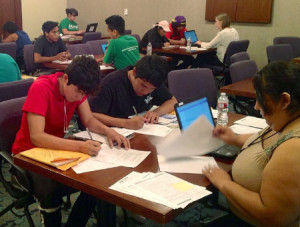
Citizenship and naturalization resources are not new to libraries, says Holmgren. “What is newsworthy is to take the next step, to provide a screening or a referral on site.”
In 2000, HPL hired Naficy to implement a grant from the Hartford Foundation for Public Giving which established The American Place, a program designed to provide core services for immigrants. The American Place, which now uses USCIS grant funding, provides citizenship workshops, English-language classes, and quarterly immigration forums—with the added benefit of opportunities to learn coping skills, socialize, and get health and digital literacy while in the library. The impetus for getting BIA R&A came about, according to Naficy, to help people with citizenship forms and access information online. When HPL applied for another grant from USCIS, it applied to get funding for the BIA program, she says.
“Immigrants become much more integrated if the program is run in a library and is provided by someone with training in librarianship,” says Naficy. While Naficy is not BIA-accredited, she notes that a full-time BIA-accredited citizenship coordinator with the library is currently pursuing her MLS.
Naficy says it is also important that a library defines its scope of services for its own BIA R&A program. “There’s no ‘one shoe fits all.’ There are some services we just don’t do,” she says. For instance, HPL will typically refer cases of fraud, domestic violence, or anything that seems criminal to other agencies. “We don’t plan to fight arbitrated cases.”
Even with these limitations, HPL serves about 500 to 600 people per year—some coming from across the state to centralized Hartford—with immigration and citizenship programming, according to Naficy.
I think it’s less intimidating for people to approach us because we’re in a library. We’re in a safe public place.Petula McShiras, supervisor of Littleton Immigrant Resources Center at Bemis Library
LIRC’s path to BIA R&A happened similarly. “There were a lot of people who were coming in who needed resources, who would go to notarios or go without legal services,” says McShiras. With site recognition, the library could better fulfill its mission to become a “one-stop resource center.”
Though the cases that come to LIRC primarily involve citizenship eligibility, McShiras says she has had a few consults for removal proceedings. Even with an attorney on staff, LIRC will refer certain cases to area organizations. “We used to give more DACA consults, but there are a few organizations here that do that better,” she says.
As of September 2015, LIRC has screened 256 individuals for citizenship eligibility and has had 136 students enrolled in citizenship classes this year. “People from other areas of Colorado definitely seek out our services,” says McShiras, noting that most come from the Southwest Denver metro area. She adds, “I think it’s less intimidating for people to approach us because we’re in a library. We’re in a safe public place.”
What’s next for Los Angeles Public Library
Los Angeles Public Library (LAPL) is in the process of considering BIA R&A as an add-on to its immigration and naturalization services. Its Path to Citizenship program launched in 2012 as an official partnership with USCIS, and ambitiously created citizenship information centers in each of the library’s 73 branch locations, according to Alicia Moguel, principal librarian for the adult services coordinating office.
LAPL has partnered with area nonprofits on classes and workshops, trained personnel on the immigration process, and now they’re figuring out if BIA R&A is feasible.
“We get people coming through the doors every day with questions about citizenship or permanent residence,” says Moguel. “Community organizations have a limited capacity. We’re asking ourselves, ‘Can we do this in-house to meet that need?’”
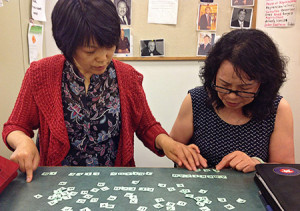
“Everything is in discussion now,” says Moguel. LAPL is considering CLINIC’s free six-week course for staff members and getting the organization to help with applications. But she says the concerns are more about what operating costs could be associated with BIA R&A services further down the road and how this program would potentially be rolled out to such a large library system.
“We have to consider the size of our system,” says Moguel. LAPL serves 3.8 million residents across 400 square miles, she says, and has served more than 17,000 people through the Path to Citizenship program since its inception—not even counting those who have attended ESL classes.
Since there is still much to be decided, she is unsure whether LAPL would try to have existing staff get BIA accreditation or if hiring already BIA-accredited individuals is a viable option.
“We’re hoping that [R&A] will enable us to do more of this work ourselves in our library branches,” says Moguel. “We’re trying to find the best way to go about it.”
Figuring out how to increase service capacity
Holmgren presented a program with Villaseñor at the 2015 ALA Annual Conference, and says many librarians in attendance requested information on BIA R&A and CLINIC as a result. He says demand is high for CLINIC’s free six-week course, and the organization tries to run trainings on a quarterly basis.
“We need to triple existing capacity, especially in those rural and underserved communities,” says Holmgren. He says that immigration attorneys are harder to find outside of big cities and sees BIA R&A as a solution.
“Capacity” is a theme at HPL too. Naficy says the library is hoping to build a program with University of Connecticut School of Law within a year or two, to recruit volunteers to help with legal services.
At Bemis Library in Littleton, Colorado, McShiras says that as the staff has grown, more people have expressed interest in becoming BIA-accredited.
Holmgren believes the time is right for libraries to add BIA R&A to their credentials, especially if DACA and DAPA are upheld, which he believes will be the case.
“[CLINIC is] standing by to help anyone who wants to do this right now,” says Holmgren. “It’s like shining a light of hope for the community.”


